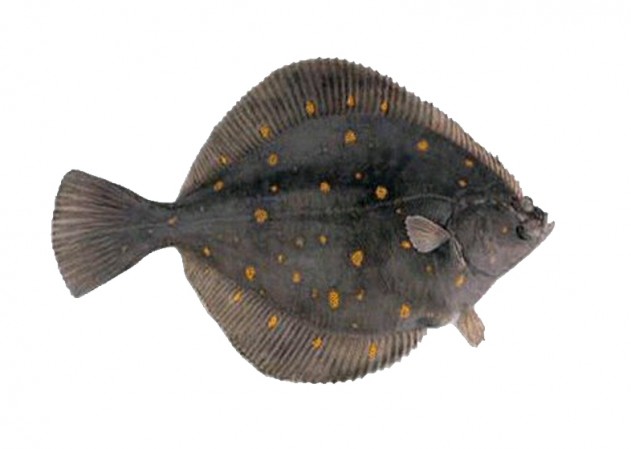Description:
Gray Flounder has deep, compressed, pear-shaped body elliptical in profile, its height slightly exceeding half its length. They have a small head and a very small mouth, its cleft less than diameter of orbit, its angle reaching about to vertical through anterior margin of lower eye. Eyes are small with diameter about 5% of head length, placed in the same vertical and close together, separated by a strongly narrow inter-orbital ridge by a space less than 1/3rd of its own diameter. Lower eye is slightly anterior to upper eye, the upper eye close to the dorsal profile. Inter-orbital ridge is low. Nostrils are in line with the inter-orbital ridge, each is in a short tube, and the posterior is being larger. The anterior nostril is halfway from the tip of the snout and the lower orbit. Maxilla extends to anterior section of lower eye; its length is less than 1/4th of a head length. Mandible is irregular and has symphysel knob, its length is noticeably more than 1/3rd of the same length.
Head length is slightly less than 1/4th (22%-26%) of standard length, snout is very short, its length is about 1/8th of a head length, 3% of standard body length, upper jaw length about 5%, ocular-side pectoral fin length 12%-24% of standard body length, caudal peduncle depth is 13%-16%, and body depth is 51%-59% of body length. Jaw teeth are small, close-set, conical, blunt, pointed, somewhat incurved and arranged in a single row. Teeth are well developed and larger on blind side than on ocular side, no teeth on vomer. Gill rakers are short and stout. Dorsal fin is beginning above eye at a point upon the blind side of the snout in the vertical through the anterior margin of the eye. Dorsal fin has 77-78 rays, the longest somewhat behind the middle of the flu, its length about 7 times in total length. Caudal fin is rounded and double truncate, the middle rays about as long as the head. Anal fin does not have spine and beginning under the base of the pectoral and has 61 rays, the longest post-medial as long as the longest in the dorsal. Pectorals normally placed with the colored side longest, equal in length to the head without snout.
Scales are thin and large, strongly pectinated on both sides, about 41 in the longitudinal series, 12 above and 14 below the lateral line. Scales are deciduous and weakly ctenoid on left side, cycloid on blind side, which is less visible on species less than 50mm in length. Primary scales on ocular side are covered with secondary supernumerary scales except for narrow posterior margin. Scales occur on snout anterior to line connecting ocular- and blind-side nostrils. Ctenii on snout scales are highly modified. Head entirely covered with scales. Lateral line is simple, very slightly curved (nearly straight) above the pectoral and equally developed on both sides. Key characters
There are 3 dark, unclear blotches irregularly placed on the lateral line. Mouth is very small with upper jaw extending to anterior portion of lower eye. Eyes are very small and set together and separated by an elevated, scaled ridge. Upper margin of head is slightly concave. Primary scales almost completely covered by many smaller, accessory scales. Body is very deep.
- 77-78 Dorsal fin rays
- 61 Anal fin rays
- 53 to 64 (usually 59 to 62) Pectoral fin rays
- 5 to 8 Gill rakers on upper limb
- 3 to 7 (usually 5) on lower limb of 1st arch
- 36 to 45 (usually 38 to 42) Lateral line scales
- 6 to 10 Precaudal vertebrae
- 24 to 25 caudal vertebrae
- Maximum length of around 5.1 in (13 cm).
Ocular side is dusky gray to brown, with a few irregularly placed indistinct brownish blotches, none of which are larger than the eye. Caudal fin lacks dark margin. Blind side is white.
Habitats:
The Gray Flounder is a demersal fish that lives in sub-tropical waters, costal habitat and offshore at depths between 7 and 180 meters (25 – 600 ft), but usually deeper than 130ft. (40 m). This little fish seems to be abundant in all warm and sandy shores of tropical America.li

